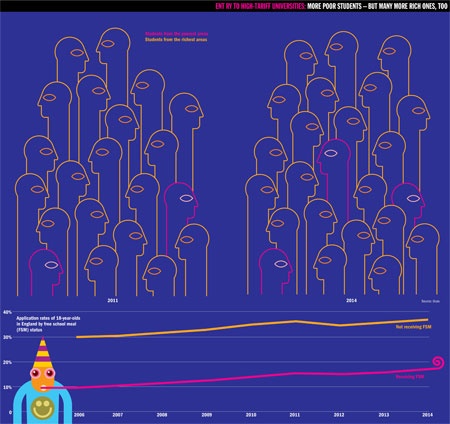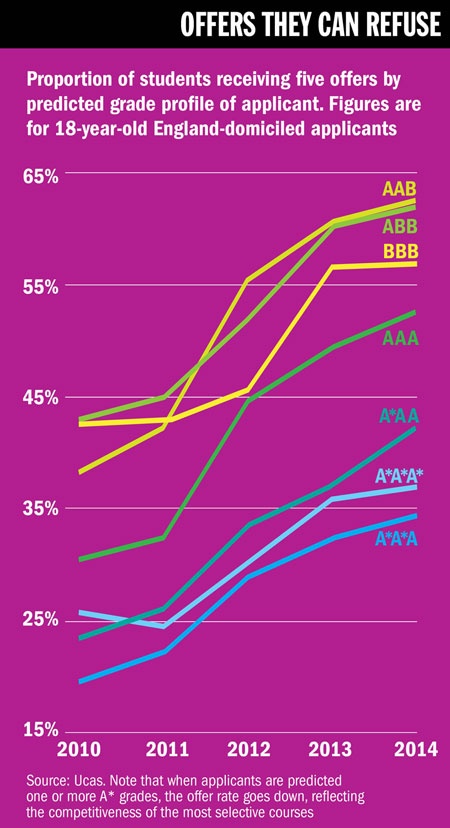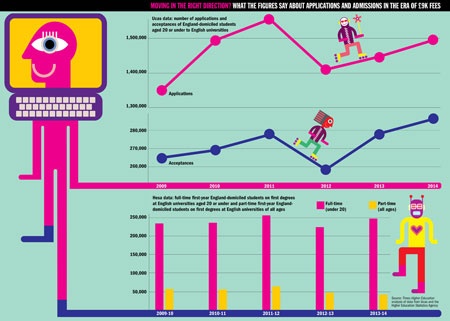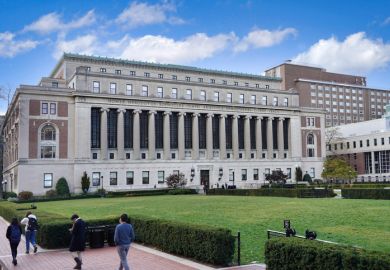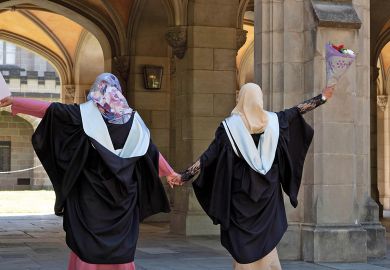The higher education playing field is changing shape. It is tipping in new directions and is about to undergo its greatest transformation yet as the free market in student numbers is ushered in.
With the first cohort of students to pay higher tuition fees entering their final months of study, and controls on university student numbers due to be removed this autumn, now seems a good time to stop and take stock of changes to the student body and university admissions.
We all know that participation in higher education is widening, but by how much? How have £9,000 annual fees changed students’ decisions and universities’ behaviour? And what might today’s admissions trends tell us about what to expect when the cap on student numbers is lifted?
1. More students are taking up places at university than ever before
This academic year is the first in which more than 500,000 students have taken up the offer of a place at a UK university, a rise of 16,800 year on year. Although most of the growth came from home students, there has also been a jump in the number of successful applicants from other European Union member states, and record numbers are arriving to take up places from other continents, too. Most of the UK students are from England – 382,500 (up 4 per cent, and one-third higher than in 2006) – and are studying in England (433,200, also up 4 per cent and the highest level recorded).
Ucas’ End of Cycle Report 2014 also shows smaller rises in the number of acceptances in Wales and a more stable situation in Northern Ireland. It is harder to judge what is occurring in Scotland because not all acceptances into higher education there are routed through Ucas.
It is England – which has by far the most expensive university tuition fees in Europe – that has produced the greatest surprise. The 2014 intake had just enough warning of what was coming to be able to make alternative arrangements before embarking on their A levels. It turns out that more pupils than ever chose to go to university, especially in England, and from the poorest of areas. Why?
2. The rise of the BTEC – but there are more students with A levels, too
Last autumn, some 30 per cent of all English 18-year-olds were accepted at university through Ucas, the highest proportion recorded at such a young age. Many more will follow just a year later – by the age of 19, more than 40 per cent of young people.
One reason for the increase in participation is that more universities are admitting students with BTEC vocational qualifications. However, the proportion of 18-year-olds entering higher education with A levels also reached a new high last autumn, so the overall increase was not due to any “dumbing down”.
Entry rates also improved for students from poor backgrounds. In 2009, just 10 per cent of English school-leavers who had received free school meals entered university. By 2014, that proportion had risen to 15 per cent. Most of that increase was a result of these students doing much better in their GCSEs. Dramatic improvements were made to poorer children’s schooling during the New Labour years. Between 2005 and 2013, the proportion of children in the UK eligible for free school meals who secured five good GCSE grades at age 16 rose from 18 per cent to 38 per cent. (The Social Mobility and Child Poverty Commission highlighted this rise in school achievement as one of the few great recent successes for mobility in its annual 2014 report.) These young people went on to do well in their sixth-form and further education colleges. It is true that in the same period more children became eligible for free school meals – rising from 12 per cent to 14 per cent of all children between the 2010 and 2014 cohorts as poverty and hunger rose across England – but that was not the main reason for the increase in participation.
Trends in entry rates from disadvantaged areas show a similar pattern. For those from the most disadvantaged areas of England and Wales, the chances of entering higher education have increased by a third in just five years. While a lot of this widening of participation is down to disadvantaged young people using BTECs for university entry in larger numbers, more of it is attributable to the dramatic doubling of good GCSE results achieved by the poorest students. Some of the improvement might also be the result of universities’ outreach work in disadvantaged areas.
3. Participation is widening at all levels – but more quickly among the affluent
Not only are more young people from disadvantaged areas going to university, they are also more likely to make it to an elite, high-tariff institution. Ucas calculates that those from the least advantaged areas were 40 per cent more likely to enter the highest-tariff institutions in 2014 than their counterparts were just three years earlier. However, young people from these areas remain an enormous seven times less likely to enter such institutions than students from the most advantaged areas; in 2006, they were nine times less likely to go. Most of the improvement has occurred in the past 12 months and has surprised many analysts, who thought higher fees would deter the poorest.
The 40 per cent headline rise in widening participation certainly looks good, but let’s put it in perspective – it is, in fact, an increase from just 2.3 per cent to 3.2 per cent of the children from the poorest areas of the UK attending the highest-tariff universities between 2011 and 2014. For every 100 children, this is not even a whole extra child. And the rise among the most disadvantaged students attending university is less than half the absolute rise in the number of successful applicants from the most advantaged areas. It is mathematically possible for poorer groups to have by far the largest increase in entry rates while the absolute differences still widen. The English higher education system provides a fine example of just such a conundrum.
Rounding to whole numbers, for every three children from the poorest areas going to the “poshest” (high-entry tariff) universities in 2014, some 21 children from the most advantaged areas also went. Three years earlier, in 2011, the respective figures were two and 19. To put this another way, for every extra child from a poorer area allowed in to a high-tariff university in 2014, an extra two from the best-off areas arrived within the same year.
For every extra child from a poorer area allowed in 2014 into a high-tariff university, another two from the best-off areas arrived in the same year
4. Students are more in demand than ever before – so many more offers are being made
The latest Ucas admissions figures give us a tantalising glimpse of what might happen this autumn when a free market is set to be introduced and universities in England will be allowed unprecedented freedom over the numbers of students they can admit.
The current labour market for the young is appalling. Some 750,000 young people – 17 per cent of 16- to 24-year-olds – are unemployed, according to the official count. Many others are underemployed, working part-time or on zero-hours contracts, or even claiming to be self-employed to avoid the stigma of unemployment. What few jobs are on offer to young adults are mostly precarious, and almost all are very low paid compared with the equivalent Northern European positions. Indeed, the largest real-terms falls in hourly wages between 2008 and 2014 were for the youngest employees in Britain. There are far fewer apprenticeships available than there are young people out of work: some 440,000 people of all ages embarked on an apprenticeship in England last year, 70,000 fewer than in 2012-13. At the same time, across most of the rest of Europe and indeed much of the globe, the Great Recession continues. This means that going abroad to work is a much less attractive option than it used to be. All these factors make university an appealing proposition. There is not much else on offer.
Meanwhile, students are worth more and more to universities because most can charge £9,000 a year tuition fees. In order to attract them, English universities are increasing their marketing spend very quickly. According to a Freedom of Information request last year by Times Higher Education, universities collectively spent more than £36 million on student marketing in 2012-13, a rise of 14.7 per cent on 2011-12 and a 33 per cent rise on 2010-11.
In this context, it is interesting to observe a fourfold increase in the number of unconditional offers being made in 2014 to candidates who did not yet have their exam results. The number of unconditional offers made was still low (12,000 – just 1.4 per cent of all offers made), but it has risen rapidly. Comparing the change in acceptances between universities that started to make more unconditional offers in 2014 and the rest suggests that this increase has had little impact on students’ choices.
What has been more important are the large increases in the total number of offers being made in recent years – almost all of them conditional. In 2014, the number of offers made by higher education institutions climbed by 100,000 year on year to reach a record 1.8 million across the UK. This is a significant shift in the pattern of offer-making: applicants are 50 per cent more likely to get a full set of five offers than their counterparts were just a few years ago.
When the cap on student numbers is removed, it would be surprising if we did not see a further rapid increase in the number of offers of all types being made in the next admissions cycle. After all, it may be more in the interest of the university than the youngster for them to study straight away at age 18. The sooner a person chooses to study, the sooner the university receives payment. Students who defer for a year have longer to think about whether and where they really want to go.
University applicants are 50 per cent more likely to get a full set of five offers than their counterparts were just a few years ago
5. Schools’ predictions are becoming less accurate
Universities’ conditional offers rely on predicted grades. Because schools find it hard to predict how well their students will do, they err towards optimism. In recent years, it has become harder to predict A-level results from GCSE results, so it is not surprising that schools are getting worse at predicting A-level achievement.
Nevertheless, it may come as a surprise to learn from the latest Ucas End of Cycle Report 2014 that: “For English 18 year olds predicted ABB [grades], the proportion attaining ABB+ fell from 32.2 per cent in 2010, 29.6 per cent (2011), 25.9 per cent (2012), 23.2 per cent (2013), to 21.0 per cent in 2014.” It is no coincidence that ABB has recently become the standard minimum requirement in many high-tariff universities. It is hard to believe that only one in five of all school students predicted ABB at A level actually achieved that result or better in 2014, but the figures are there in black and white on page 67 of the report.
Although UK universities have GCSE and other indicators to suggest who might do well at A level, wouldn’t it be so much better to do what is done in the Republic of Ireland and much of the rest of the more civilised world, and make offers based on what young people actually achieve – with them applying after achieving it? More would then be nearer to adulthood, to age 18. More might consider other, cheaper and more adventurous options, such as studying in mainland Europe.
If universities were less insistent on entrants achieving ABB grades in future, schools might be less tempted to inflate their predictions accordingly. Certainly, universities are likely to become less focused on top grades when the student number system changes. From this autumn, they will be able to take any number of students, not just any number achieving ABB or above.
As the system expands, what will become of more interest are the wide variations between different parts of the country in the proportion of students entering higher education with BTECs. At the moment, for example, in the city of Cambridge, just 1 per cent of school-age students who study BTEC qualifications go on to university. In contrast, in Wolverhampton North East, Blackpool North and Cleveleys, and Blackpool South, 17 per cent of all young people who won a university place in 2014 did so via the BTEC route. Did you know that poor youngsters growing up in places such as Oxford and Cambridge have lower chances of getting to university than their counterparts in Wolverhampton and Blackpool?
The latest admissions data show that the higher education sector is a safe haven in troubled times. With few other options available to school-leavers, universities have opened their doors to unprecedented numbers of young people from an unprecedentedly wide range of backgrounds. Higher-tariff institutions have behaved as they have never done before in accepting record numbers of students from disadvantaged areas, especially within the past 12 months – although their intake from such areas remains derisory.
But none (or very little) of the recent change is driven by altruism. The correlation between student numbers rising faster in England and fees rising highest in England is far too much of a coincidence for altruism to be the cause. The financial incentives for institutions to take on more students have never been greater. As universities enrol more students, this inevitably will be followed by the greatest increase in debt ever experienced by young adults in England.
Indeed, more debt has been amassed by young people in England in the past few years than in all the previous centuries combined – a result of decisions made by children about whether or not to go to university. Most had little real choice about whether or not to take on the debt.
But, to corrupt an old line and remain optimistic, while there are seats to be sat in and time to advance, let’s face the music and dance.

6. Minority report: the gender gap is growing
More young men than ever before are going to university in England, yet the gap in entry rates between them and young women is wider than ever – 8.5 percentage points by age 18 alone, with women a third more likely to go than men – and is growing wider still.
By 2014, women were 26 per cent more likely to gain access to high-tariff universities than men, up from 18 per cent in 2006. In the lowest-tariff universities, women have in recent years been up to 50 per cent more likely to gain entry than men. It is now only in a tiny number of often extremely elite and more science-based institutions that male undergraduates remain in the (narrow) majority.
This helps to explain why, in some parts of the UK, young women who do not go to university by the age of 18 now find themselves in the minority. This was true of a dozen of the UK’s 650 parliamentary constituencies in 2014 – mostly in London – including the now affluent constituencies of Beaconsfield; Beckenham; Chesham and Amersham; Hitchin and Harpenden; Mole Valley; Ruislip, Northwood and Pinner; St Albans; and Twickenham. In no UK constituency was the same true of men.
Of course, in other parts of the UK, the number of young people entering higher education remains startlingly low: looking at the proportion of young men who go to university by parliamentary constituency reveals some particularly striking findings. In 2014, there were a dozen constituencies in which only between one in seven and one in 10 men got to university by the age of 18: Aberavon; Brighton, Kemptown; Bristol East; Bristol South; Clwyd South; Great Yarmouth; Hastings and Rye; Kingston upon Hull North; Nottingham North; Plymouth, Moor View; Portsmouth North; and Sheffield, Brightside and Hillsborough. All of them are deprived neighbourhoods.
In January last year, Mary Curnock Cook, the chief executive of Ucas, sounded a warning that young men were becoming a “disadvantaged group” when it came to university applications.
“There remains a stubborn gap between male and female applicants which, on current trends, could eclipse the gap between rich and poor within a decade,” she said.
Elsewhere in higher education, however, women are very much in the minority. Most professors are men (78 per cent), as are 80 per cent of vice-chancellors.
Danny Dorling
Moving in the right direction? What the figures say about applications and admissions in the era of £9K fees
When MPs voted to triple the cap on tuition fees in England, there were protests on the streets and warnings that the hike could damage participation and social mobility.
The decision led to a flood of university applications in 2011-12 as young people rushed to study in the final year of lower fees, but demand for places fell significantly in 2012-13, the first year of the new system.
However, figures published last month show that the number of university applications and enrolments has recovered to 2010-11 levels – but only among some groups.
Among English students at English institutions, the number of applications made by young people through Ucas for 2014 entry is back at 2010 levels (just under 1.5 million, and 11 per cent higher than in 2009).
The number of acceptances has climbed since 2012 and is now 6 per cent higher than in 2010 (see graph above).
Data from the Higher Education Statistics Agency released on 15 January show that the rise in acceptances has followed through into enrolments, with the number of first-year students aged 20 or under on full-time first-degree courses in the 2013-14 academic year up 5 per cent on 2010-11.
However, this positive news has been accompanied by a significant drop in the number of mature and part-time students, points out Conor Ryan, director of research and communications at the Sutton Trust.
In England, 26 per cent fewer part-time students began first-degree courses in 2013-14 than in 2009-10.
This is “a real problem”, says Ryan, because part-time degrees are important for social mobility and are often a route into higher education for those who did not get the chance to go to university when they left school.
He stresses that the “government and universities need to investigate why that has happened”.
Ryan believes that the data on efforts to widen participation need closer scrutiny, too.
While official figures show an improvement, with a growing proportion of school-leavers from disadvantaged backgrounds gaining entry to university, at the most prestigious institutions the gap in participation between rich and poor students remains very wide.
Money spent on access and outreach should be better targeted so that more of it reaches schools, he argues.
“One of the concerns that we have, for example, is teachers’ perceptions of Oxbridge,” he says.
“A Sutton Trust poll last year showed that 45 per cent of state school-teachers believe that up to 30 per cent of students at Oxford and Cambridge are state school-leavers, when in fact the proportion is about 60 per cent.”
Meanwhile, with different universities offering different financial packages for students from poorer backgrounds, the financial system “can be quite difficult for young people and their teachers to navigate”. This should be simplified, he adds.
Holly Else
Register to continue
Why register?
- Registration is free and only takes a moment
- Once registered, you can read 3 articles a month
- Sign up for our newsletter
Subscribe
Or subscribe for unlimited access to:
- Unlimited access to news, views, insights & reviews
- Digital editions
- Digital access to THE’s university and college rankings analysis
Already registered or a current subscriber? Login

